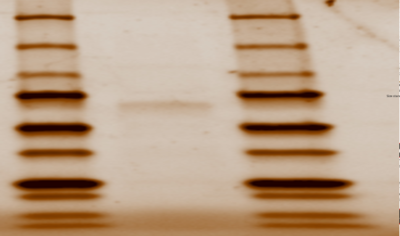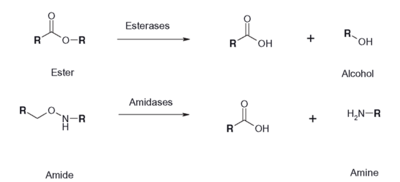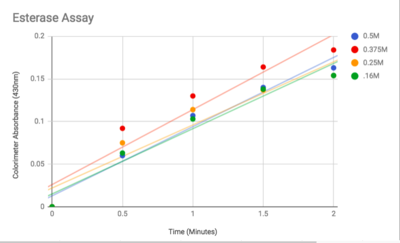User:Jennifer Taylor/Sandbox 5
From Proteopedia
| Line 8: | Line 8: | ||
Proteins are one of the four major macromolecules in biology. Present in nearly every living organism, proteins have a diverse set of functions ranging from regulating cell activity to catalyzing reactions. Proteins are primary made up of amino acids in the primary structure, which consists of the amino acid sequence. The amino acids are set in a particular order so that they perform a specific function, and this order is determined by the DNA gene that codes for amino acids. The secondary structure consists of <scene name='78/787196/Alpha_helixes_of_2qru/1'>Alpha Helix</scene> and <scene name='78/787196/Beta_sheets_of_2qru/1'>Beta Sheet</scene> . These two structures are helpful in finding similar proteins that perform similar functions. The tertiary and and quaternary structures consist of the specific folding of the complete protein structure, which all comes togther in great importance when classifying proteins. [https://www.khanacademy.org/science/biology/macromolecules/proteins-and-amino-acids/a/orders-of-protein-structure] | Proteins are one of the four major macromolecules in biology. Present in nearly every living organism, proteins have a diverse set of functions ranging from regulating cell activity to catalyzing reactions. Proteins are primary made up of amino acids in the primary structure, which consists of the amino acid sequence. The amino acids are set in a particular order so that they perform a specific function, and this order is determined by the DNA gene that codes for amino acids. The secondary structure consists of <scene name='78/787196/Alpha_helixes_of_2qru/1'>Alpha Helix</scene> and <scene name='78/787196/Beta_sheets_of_2qru/1'>Beta Sheet</scene> . These two structures are helpful in finding similar proteins that perform similar functions. The tertiary and and quaternary structures consist of the specific folding of the complete protein structure, which all comes togther in great importance when classifying proteins. [https://www.khanacademy.org/science/biology/macromolecules/proteins-and-amino-acids/a/orders-of-protein-structure] | ||
| - | Enzymes, proteins that catalyze reactions, are grouped into seven major classes based on amino acid sequence similarity and secondary structure proportions. Proteins in each class share unique properties that can classify them into more detailed subclasses. Protein structure and protein function are closely related. This means that identifying highly conserved sequences between two proteins increases the likelihood of discovering shared functions. In this study we attempted to compare the sequence and structure of an uncharacterized protein to that of a protein with a known function in order to understand the former protein’s function. In 2000, the Protein Structure Initiative began an attempt to solve the 3D-structures of proteins with known sequences in order to begin understanding their functions. But, in 2015, the Initiative no longer had the proper funding and stopped, successfully solving 6920 structures, but leaving many structures found without their functions classified as well. What we set out to do was choose a protein with a found structure, perform sequential, structural, and enzymatic analysis. | + | Enzymes, proteins that catalyze reactions, are grouped into seven major classes based on amino acid sequence similarity and secondary structure proportions. Proteins in each class share unique properties that can classify them into more detailed subclasses. Protein structure and protein function are closely related. This means that identifying highly conserved sequences between two proteins increases the likelihood of discovering shared functions. In this study we attempted to compare the sequence and structure of an uncharacterized protein to that of a protein with a known function in order to understand the former protein’s function. In 2000, the Protein Structure Initiative began an attempt to solve the 3D-structures of proteins with known sequences in order to begin understanding their functions. But, in 2015, the Initiative no longer had the proper funding and stopped (5), successfully solving 6920 structures (6), but leaving many structures found without their functions classified as well. What we set out to do was choose a protein with a found structure, perform sequential, structural, and enzymatic analysis. |
==Bacterial Transformation, Protein Expression, and Protein Purification== | ==Bacterial Transformation, Protein Expression, and Protein Purification== | ||
| Line 16: | Line 16: | ||
==Structural Highlights== | ==Structural Highlights== | ||
| - | In our research to find similar proven protein structures to our 2QRU because we know that structure dictates function, we used several computational analysis systems to align our sequences and also align our structures. After obtaining the protein, BLAST, PDB, ProMol were used to find the most structurally similar proteins to 2QRU. First, proteins with similar sequences were searched for, because we assumed that if the sequences were similar, than the structures might be as well. On these databases, [https://www.rcsb.org/structure/1TAH 1TAH], [https://www.rcsb.org/structure/1c4x 1C4X] and [https://www.rcsb.org/structure/3FAK 3FAK], all in the esterase sub-family, proved to be the most structurally similar after searching for the the motifs and aligned active sites on ProMol. ProMol was important because we were able to find the <scene name='78/787196/2qru_active_site/3'>Active Site of 2QRU</scene>. The active site is where reactions happen, so if the active sites were similar, then maybe the reactions would be so too. We used PyMol to align the 3D structures and the active sites to analyze the similarities between the three proteins with known functions. PyMol allowed us to come to the conclusion that since the three proteins were all in the Esterase family, we could then use an assay that would wither prove or disprove if 2QRU was an esterase. | + | In our research to find similar proven protein structures to our 2QRU because we know that structure dictates function, we used several computational analysis systems to align our sequences and also align our structures. After obtaining the protein, BLAST, PDB, ProMol, Pfam, and Dali (7,8,9,10) were used to find the most structurally similar proteins to 2QRU through sequence and structure analysis. First, proteins with similar sequences were searched for, because we assumed that if the sequences were similar, than the structures might be as well. On these databases, [https://www.rcsb.org/structure/1TAH 1TAH], [https://www.rcsb.org/structure/1c4x 1C4X] and [https://www.rcsb.org/structure/3FAK 3FAK], all in the esterase sub-family, proved to be the most structurally similar after searching for the the motifs and aligned active sites on ProMol. ProMol was important because we were able to find the <scene name='78/787196/2qru_active_site/3'>Active Site of 2QRU</scene>. The active site is where reactions happen, so if the active sites were similar, then maybe the reactions would be so too. We used PyMol to align the 3D structures and the active sites to analyze the similarities between the three proteins with known functions. PyMol allowed us to come to the conclusion that since the three proteins were all in the Esterase family, we could then use an assay that would wither prove or disprove if 2QRU was an esterase. |
==Functional Assay== | ==Functional Assay== | ||
| Line 50: | Line 50: | ||
4. Nandhagopal, N., Senda, T., Hatta, T., Yamada, A., Masai, E., Fukuda, M., Mitsui, Y. Three-Dimensional Structure of Microbial 2-Hydroxyl-6-Oxo-6-Phenylhexa-2,4- Dienoic Acid (Hpda) Hydrolase (Bphd Enzyme) from Rhodococcus Sp. Strain Rha1, in the Pcb Degradation Pathway. | 4. Nandhagopal, N., Senda, T., Hatta, T., Yamada, A., Masai, E., Fukuda, M., Mitsui, Y. Three-Dimensional Structure of Microbial 2-Hydroxyl-6-Oxo-6-Phenylhexa-2,4- Dienoic Acid (Hpda) Hydrolase (Bphd Enzyme) from Rhodococcus Sp. Strain Rha1, in the Pcb Degradation Pathway. | ||
(1997) Proc.Jpn.Acad.,Ser.B 73: 154 | (1997) Proc.Jpn.Acad.,Ser.B 73: 154 | ||
| + | |||
| + | 5. ProMol Project. Dr. Paul Craig, Dr. Herbert Bernstein, Dr. Jeff Mills at Rochester Institute of Technology. | ||
| + | |||
| + | 6. "Milestones Tables." PSI Structural Biology Knowledgebase. Accessed April 27, | ||
| + | 2018. http://targetdb.pdb.org/Metrics/MilestonesTables.html. | ||
| + | |||
| + | 7. Altschul, S.F., Gish, W., Miller, W., Myers, E.W. & Lipman, D.J. (1990) "Basic local alignment search tool." J. Mol. Biol. 215:403-410. PubMed. | ||
| + | |||
| + | 8.The PyMOL Molecular Graphics System, Version 2.0 Schrödinger, LLC. | ||
| + | |||
| + | 9.Liisa Holm; Laura M. Laakso (2016) Dali server update. Nucleic acids research 44 (W1), W351-W355. PDF | ||
| + | |||
| + | 10.The Pfam protein families database: towards a more sustainable future: R.D. Finn, P. Coggill, R.Y. Eberhardt, S.R. Eddy, J. Mistry, A.L. Mitchell, S.C. Potter, M. Punta, M. Qureshi, A. Sangrador-Vegas, G.A. Salazar, J. Tate, A. BatemanNucleic Acids Research (2016) Database Issue 44:D279-D285 | ||
| + | |||
| + | |||
<references/> | <references/> | ||
Revision as of 14:55, 21 May 2018
2QRU
Here is a cartoon image of my protein:
| |||||||||||
References
2. Nam K.H., Kim M.Y., Kim S.J., Priyadarshi A., Lee W.H., Hwang K.Y. Structural and functional analysis of a novel EstE5 belonging to the subfamily of hormone-sensitive lipase. (2009) Biochem Biophys Res Commun 379: 553-6 Pubmed Article: 19116143
3. Noble M.E., Cleasby A., Johnson L.N., Egmond M.R., Frenken L.G. The crystal structure of triacylglycerol lipase from Pseudomonas glumae reveals a partially redundant catalytic aspartate. (1993) FEBS Lett 331: 123-8 Pubmed Article: 8405390
4. Nandhagopal, N., Senda, T., Hatta, T., Yamada, A., Masai, E., Fukuda, M., Mitsui, Y. Three-Dimensional Structure of Microbial 2-Hydroxyl-6-Oxo-6-Phenylhexa-2,4- Dienoic Acid (Hpda) Hydrolase (Bphd Enzyme) from Rhodococcus Sp. Strain Rha1, in the Pcb Degradation Pathway. (1997) Proc.Jpn.Acad.,Ser.B 73: 154
5. ProMol Project. Dr. Paul Craig, Dr. Herbert Bernstein, Dr. Jeff Mills at Rochester Institute of Technology.
6. "Milestones Tables." PSI Structural Biology Knowledgebase. Accessed April 27, 2018. http://targetdb.pdb.org/Metrics/MilestonesTables.html.
7. Altschul, S.F., Gish, W., Miller, W., Myers, E.W. & Lipman, D.J. (1990) "Basic local alignment search tool." J. Mol. Biol. 215:403-410. PubMed.
8.The PyMOL Molecular Graphics System, Version 2.0 Schrödinger, LLC.
9.Liisa Holm; Laura M. Laakso (2016) Dali server update. Nucleic acids research 44 (W1), W351-W355. PDF
10.The Pfam protein families database: towards a more sustainable future: R.D. Finn, P. Coggill, R.Y. Eberhardt, S.R. Eddy, J. Mistry, A.L. Mitchell, S.C. Potter, M. Punta, M. Qureshi, A. Sangrador-Vegas, G.A. Salazar, J. Tate, A. BatemanNucleic Acids Research (2016) Database Issue 44:D279-D285
- ↑ Hanson, R. M., Prilusky, J., Renjian, Z., Nakane, T. and Sussman, J. L. (2013), JSmol and the Next-Generation Web-Based Representation of 3D Molecular Structure as Applied to Proteopedia. Isr. J. Chem., 53:207-216. doi:http://dx.doi.org/10.1002/ijch.201300024
- ↑ Herraez A. Biomolecules in the computer: Jmol to the rescue. Biochem Mol Biol Educ. 2006 Jul;34(4):255-61. doi: 10.1002/bmb.2006.494034042644. PMID:21638687 doi:10.1002/bmb.2006.494034042644




